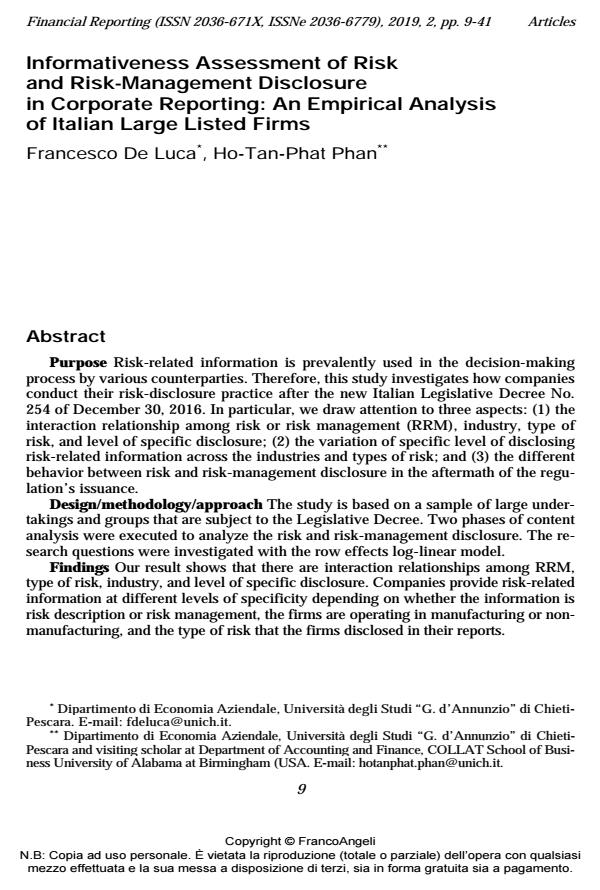Informativeness Assessment of Risk and Risk-Management Disclosure in Corporate Reporting: An Empirical Analysis of Italian Large Listed Firms
Titolo Rivista FINANCIAL REPORTING
Autori/Curatori Francesco De Luca, Ho-Tan-Phat Phan
Anno di pubblicazione 2019 Fascicolo 2019/2
Lingua Inglese Numero pagine 33 P. 9-41 Dimensione file 164 KB
DOI 10.3280/FR2019-002002
Il DOI è il codice a barre della proprietà intellettuale: per saperne di più
clicca qui
Qui sotto puoi vedere in anteprima la prima pagina di questo articolo.
Se questo articolo ti interessa, lo puoi acquistare (e scaricare in formato pdf) seguendo le facili indicazioni per acquistare il download credit. Acquista Download Credits per scaricare questo Articolo in formato PDF

FrancoAngeli è membro della Publishers International Linking Association, Inc (PILA)associazione indipendente e non profit per facilitare (attraverso i servizi tecnologici implementati da CrossRef.org) l’accesso degli studiosi ai contenuti digitali nelle pubblicazioni professionali e scientifiche
Purpose Risk-related information is prevalently used in the decision-making process by various counterparties. Therefore, this study investigates how compa-nies conduct their risk-disclosure practice after the new Italian Legislative Decree No. 254 of December 30, 2016. In particular, we draw attention to three aspects: (1) the interaction relationship among risk or risk management (RRM), industry, type of risk, and level of specific disclosure; (2) the variation of specific level of disclosing risk-related information across the industries and types of risk; and (3) the different behavior between risk and risk-management disclosure in the after-math of the regulation’s issuance. Design/methodology/approach The study is based on a sample of large un-dertakings and groups that are subject to the Legislative Decree. Two phases of content analysis were executed to analyze the risk and risk-management disclosure. The research questions were investigated with the row effects loglinear model. Findings Our result shows that there are interaction relationships among RRM, type of risk, industry, and level of specific disclosure. Companies provide risk-related information at different levels of specificity depending on whether the information is risk description or risk management, the firms are operating in manu-facturing or nonmanufacturing, and the type of risk that the firms disclosed in their reports. Practical implications The paper provides evidence of inconsistent company behavior in disclosing company-specific information in favor of internal and ex-ternal stakeholders, particularly by balancing company-specific disclosure be-tween risk descriptions and risk-management policies. Policymakers might also consider this current phenomenon to decide to what extent disclosure requirements should be detailed and, instead, what room should be left for management discre-tion with respect to users’ needs. Originality/value This paper is an up-to-date assessment of Italian firms’ compliance with Legislative Decree No. 254 of December 30, 2016.
Parole chiave:Risk disclosure, risk-management disclosure, level of specific disclosure, nonfinancial information
Jel codes:G38, M48, M14, M40
- Mandatory Non-financial Risk-Related Disclosure Stefania Veltri, pp.3 (ISBN:978-3-030-47920-6)
- Mandatory Non-financial Risk-Related Disclosure Stefania Veltri, pp.89 (ISBN:978-3-030-47920-6)
- Risk disclosure in sustainability reports: Empirical evidence from the energy sector Filippo Vitolla, Nicola Raimo, Francesco Campobasso, Anastasia Giakoumelou, in Utilities Policy 101587/2023 pp.101587
DOI: 10.1016/j.jup.2023.101587 - Mandatory Non-financial Risk-Related Disclosure Stefania Veltri, pp.133 (ISBN:978-3-030-47920-6)
- Non-financial Disclosure and Integrated Reporting Claudia Arena, Simona Catuogno, Rita Lamboglia, Antonella Silvestri, Stefania Veltri, pp.29 (ISBN:978-3-030-90354-1)
- Market Valuation of Risk Reporting: The Role of Business Model Disclosure Chiara Crovini, Francesco Giunta, Christian Nielsen, Lorenzo Simoni, in Abacus abac.12342/2024
DOI: 10.1111/abac.12342 - Mandatory Non-financial Risk-Related Disclosure Stefania Veltri, pp.57 (ISBN:978-3-030-47920-6)
- Mandatory Non-financial Risk-Related Disclosure Stefania Veltri, pp.31 (ISBN:978-3-030-47920-6)
- Managing cyber risk in the financial sector: Insights from a case study Chiara Crovini, Pier Luigi Marchini, in FINANCIAL REPORTING 1/2023 pp.97
DOI: 10.3280/FR2023-001004 - Including Sustainable Reporting Practices in Corporate Management Reports: Assessing the Impact of Transparency on Economic Performance Anca Băndoi, Claudiu George Bocean, Mara Del Baldo, Lucian Mandache, Leonardo Geo Mănescu, Cătălina Soriana Sitnikov, in Sustainability /2021 pp.940
DOI: 10.3390/su13020940
Francesco De Luca, Ho-Tan-Phat Phan, Informativeness Assessment of Risk and Risk-Management Disclosure in Corporate Reporting: An Empirical Analysis of Italian Large Listed Firms in "FINANCIAL REPORTING" 2/2019, pp 9-41, DOI: 10.3280/FR2019-002002